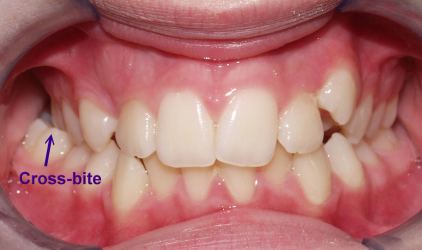Specialty orthodontics ICD-9-CM 524.27 | ICD-10 K07.2 | |
 | ||
Crossbite is a form of malocclusion where a tooth (or teeth) has a more buccal or lingual position (that is, the tooth is either closer to the cheek or to the tongue) than its corresponding antagonist tooth in the upper or lower dental arch. In other words, crossbite is a lateral misalignment of the dental arches.
Contents
Anterior Crossbite
An anterior cross bite can be referred as negative overjet, and is typical of class III skeletal relations (prognathism).
Primary/Mixed Dentitions
An anterior crossbite in a child with baby teeth or mixed dentition may happen due to palatal displaced upper anterior permanent teeth,
Posterior Crossbite
Bjork defined posterior crossbite as a malocclusion where the buccal cusps of canine, premolar and molar of upper teeth occlude lingually to the buccal cusps of canine, premolar and molar of lower teeth. Posterior crossbite is often correlated to a narrow maxilla and upper dental arch. A posterior cross-bite can be unilateral, bilateral, single-tooth or entire segment crossbite. Posterior crossbite has been reported to occur between 7%-23% of the population. The most common type of posterior crossbite to occur is the unilateral crossbite which occurs in 80% to 97% of the posterior crossbite cases. Posterior crossbites also occur most commonly in primary and mixed dentition. This type of crossbite usually presents with a functional shift of the mandible towards the side of the crossbite. Posterior crossbite can occur due to either skeletal, dental or functional abnormalities. One of the common reasons for development of posterior crossbite is the size difference between maxilla and mandible, where maxilla is smaller than mandible.
Posterior crossbite can result due to
Posterior crossbites can be unilateral, bilateral, single-tooth or multiple teeth.
Unilateral Crossbite
Unilateral cross-bite involves one side of the arch. The most common cause of unilateral crossbite is a narrow maxillary dental arch. This can happen due to habits such as digit sucking, prolonged use of pacifier or upper airway obstruction. Due to the discrepancy between the maxillary and mandibular arch, neuromuscular guidance of the mandible causes mandible to close forcibly towards the side of the crossbite. Thus a lateral shift of the mandibular position occurs, which can become structural if left untreated for a long time during growth, leading to skeletal asymmetries. Unilateral crossbites can present with following features in a child
Single-Tooth Crossbite
Single tooth crossbites can occur due to uneruption of a primary teeth in a timely manner which causes permanent tooth to erupt in a different eruption pattern.
Treatment
A child with posterior crossbite should be treated immediately if the child shifts his mandible on closing which is often seen in a unilateral crossbite as mentioned above. The best age to treat a child with crossbite is in their mixed dentition when their palatal sutures have not fused to each other. Expanding the palatal allows more space in an arch to allow either teeth to erupt relieving crowding or allowing posterior crossbite to correct. The correction can include any type of palatal expanders that will expand the palate which fixes the narrow constriction of the mandible. There are several therapies that can be used to correct a cross bite: braces, 'Z' spring or cantilever spring, quad helix, removable plates, clear aligner therapy, or a Delaire mask. The correct therapy should be decided by the orthodontist depending on the type and severity of the crossbite.
Goal to treat unilateral crossbites should definitely include removal of occlusal interferences and elimination of the functional shift. Treating posterior crossbites early may help prevent the occurrence of Temporomandibular joint pathology.
Unilateral crossbites can also be diagnosed and treated properly by using a Deprogramming splint. This splint has flat occlusal surface which causes the muscles to deprogram themselves and establish new sensory engrams. When the splint is removed, a proper centric relation bite can be diagnosed from the bite.
Self-Correction
Literature states that very few crossbites tend to self-correct which often justify the treatment approach of correcting these bites as early as possible. Only 0-9% of crossbites self-correct. Lindner et al. reported that in a 50% of crossbites were corrected in 76 four year old children.
